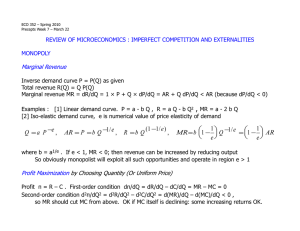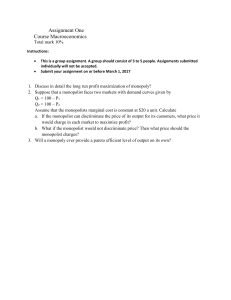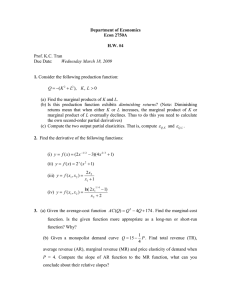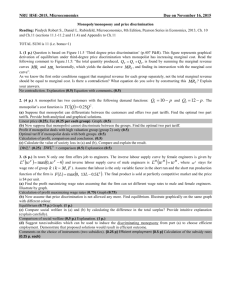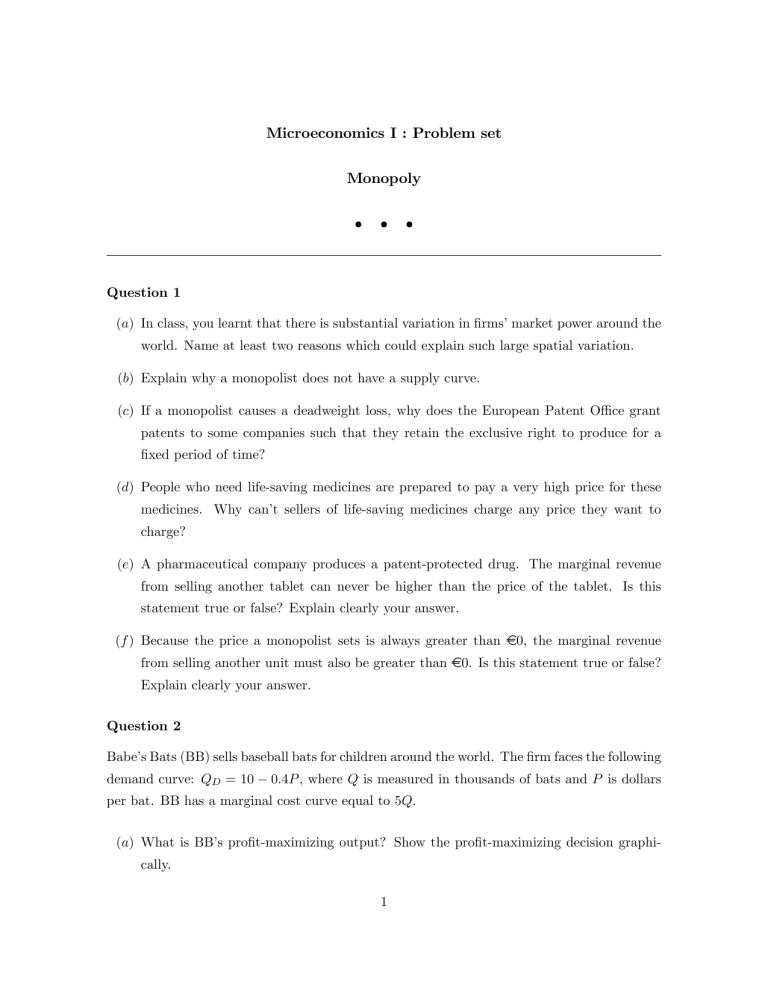
Microeconomics I : Problem set Monopoly Question 1 (a) In class, you learnt that there is substantial variation in …rms’market power around the world. Name at least two reasons which could explain such large spatial variation. (b) Explain why a monopolist does not have a supply curve. (c) If a monopolist causes a deadweight loss, why does the European Patent O¢ ce grant patents to some companies such that they retain the exclusive right to produce for a …xed period of time? (d) People who need life-saving medicines are prepared to pay a very high price for these medicines. Why can’t sellers of life-saving medicines charge any price they want to charge? (e) A pharmaceutical company produces a patent-protected drug. The marginal revenue from selling another tablet can never be higher than the price of the tablet. Is this statement true or false? Explain clearly your answer. (f ) Because the price a monopolist sets is always greater than e0, the marginal revenue from selling another unit must also be greater than e0. Is this statement true or false? Explain clearly your answer. Question 2 Babe’s Bats (BB) sells baseball bats for children around the world. The …rm faces the following demand curve: QD = 10 0:4P , where Q is measured in thousands of bats and P is dollars per bat. BB has a marginal cost curve equal to 5Q. (a) What is BB’s pro…t-maximizing output? Show the pro…t-maximizing decision graphically. 1 (b) What price will BB charge to maximize its pro…ts? (c) Calculate the deadweight loss from market power at the …rm’s pro…t-maximizing level of output. Question 3 The Power Tires Company has market power and faces the demand curve shown in the graph below. The …rm’s marginal cost curve is M C = 30 + 3Q. (a) What are the …rm’s pro…t-maximizing output and price? (b) If the …rm’s demand declines to P = 240 2Q, what is the …rm’s pro…t-maximizing level of output and price? How does this compare to your answer to question (a)? Draw a graph showing the two pro…t-maximizing output-price combinations of (a) and (b). (c) Holding marginal cost equal, how does the shape of the demand curve a¤ect the …rm’s ability to charge a higher price? (d) Quantify the …rm’s market power under the two demand scenarios. Question 4 Suppose Exxon Mobile purchased every gas company in the world and set their prices. Then, it would have a control of the gas market with no other competition. Thus Exxon Mobile becomes a monopolist in providing gas. The market demand curve faced by Exxon Mobile is P = Q + 40, and Exxon Mobile’s cost is given by T C = Q2 + 140. 2 (a) Draw the demand curve, M R-curve, AT C-curve and M C-curve for this monopolist in a graph. (b) What is the monopolist’s pro…t-maximizing production quantity? What price will the monopolist charge? (c) Compute the consumer surplus, producer surplus and pro…ts for the monopolist. Now, suppose there is a technological change for the monopolist, and its total cost is now given by T C = 20Q. There are no …xed costs. (d) What is the monopolist’s pro…t-maximizing production quantity? What price will the monopolist charge? Show these values in a graph. Suppose this market was a perfectly competitive market, that is, the monopolist’s demand curve is still the market demand curve, but now there are many …rms providing gas for the market. (e) What would be the equilibrium price and quantity in this perfectly competitive market? (f ) Assume the technological change in the market is still true. What is the deadweight loss caused by the monopolist? Question 5 In Amstelveen Sandor sells 15 cloves at a price of e5 each. If Sandor lowers his price by 10%, to e4.50 per clove, he will sell 16, or 6.67% more. In Zaandam, Nynke sells 15 cloves for e5 each. If Nynke lowers her price by 2%, to e4.90, she will sell 16 cloves, or 6.67% more. (a) Classify the demand curves that Sandor and Nynke face as elastic or inelastic. (b) Determine the marginal revenue of the 16th unit for Sandor. Compute the marginal revenue of the 16th unit for Nynke. 3 Question 6 Suppose that econometricians at Hallmark Cards determine that the price elasticity of demand for greeting cards is 2. (a) If Hallmark’s marginal cost of producing cards is constant and equal to $1.00, use the Lerner index to determine what price Hallmark should charge to maximize pro…t. Hallmark hires you to estimate the price elasticity of demand faced by its archrival, American Greetings. Hallmark estimates that American’s marginal cost of producing a greeting card is $1.22. You note that American’s cards sell for an average of $3.25. (b) Assuming that American Greetings is maximizing pro…t, calculate their price elasticity of demand. Question 7 Suppose that a monopolistic seller of designer handbags faces the following inverse demand curve: P = 50 0:4Q. The seller can produce handbags for a constant marginal and average total cost of $10. (a) Calculate the long-run pro…t-maximizing price for this seller. Suppose the government levies a $4 tax per unit on sellers of handbags. (b) Calculate how this tax will a¤ect the price the monopolist charges its customers. (c) Who bears the burden of this tax? 4 Question 8 Consider the …rm depicted in the graph below. (a) Is the …rm a natural monopoly? How do you know? (b) Will this …rm earn a pro…t if it is not subject to regulation? How do you know? (c) If the government requires the …rm to charge no more than its marginal cost of production, how many units will be sold? At what price? What is the problem with the government capping prices at marginal cost? (d) Suppose the government allows …rms to charge no more than their average total costs of production. How many units will this …rm sell? At what price? What is the problem with capping prices at average total cost? (e) Evaluate the deadweight loss under each of the three pricing regimes above. Show each regime’s deadweight loss as an area on the graph. 5 Question 9 A monopolist faces an inverse demand curve of P = 90 Q. It has a constant marginal cost and a constant average total cost of 30 each. (a) If the monopolist can perfectly price discriminate, what is its pro…t? What are consumer surplus, welfare and deadweight loss? (b) How would the results, that is, the pro…t of the monopolist, consumer surplus, welfare and deadweight loss, change if the …rm were a single-price monopolist? Question 10: Multiple choice 10.1. Market power occurs when a …rm: (a) can sell additional units of output without lowering the price of its product. (b) must sell additional units of output at a constant marginal cost. (c) can in‡uence the price of its product. (d) maximizes pro…t at the output level where P = M C. 10.2. Mobile phone portability allows consumers to retain their phone number if they change to a di¤erent phone network, which will tend to: (a) increase barriers to entry in the phone industry. (b) discourage product di¤erentiation and increase switching costs. (c) encourage the formation of natural monopolies. (d) reduce market power in the phone industry. 6 10.3. Bubba Golf, a manufacturer of golf clubs, can sell 3 drivers at e600 each. To sell 4 drivers, Bubba Golf must lower the price to e580 each. The marginal revenue of the fourth club is: (a) e20. (b) e60. (c) e580. (d) e520. 10.4. Suppose a …rm lowers its price to $10, raising the quantity sold from 4 to 5 units. If the marginal revenue of the …fth unit is e2, the …rm must have lowered its price by: (a) e8. (b) e2. (c) e4. (d) e10. 10.5. A …rm’s demand curve is given by Q = 100 0:67P . What is the …rm’s corresponding marginal revenue curve? (a) 150 0:67Q. (b) 100 0:67Q. (c) 150 3Q. (d) 150 1:5Q. 10.6. The marginal revenue from expanding output from Q1 to Q2 is represented by area: 7 (a) C: (b) B + C (c) B D (d) A + D B 10.7. At the pro…t-maximizing quantity, the …rm’s marginal cost is $40 and it charges a price of $60. What is the price elasticity of demand at the pro…t-maximizing quantity? (a) 0:67: (b) 1:5 (c) 3: (d) 0:5: 10.8. A …rm with market power has an inverse demand curve of P = 450 5Q and marginal cost of M C = 40Q, where Q is measured in thousands. What is the deadweight loss from market power at the …rm’s pro…t-maximizing output level? (a) $15; 000: (b) $280; 000: (c) $22; 500: (d) $9; 400: 8 10.9. A drug company produces a new drug to treat baldness. The inverse demand curve for the drug is P = 205 20Q, where Q measures the number of pills in millions. The various costs of production are given by T C = 100 + 5Q. If the government grants this …rm a patent, it will earn pro…ts of _____. If the government revokes the patent and the …rm must sell its drug at marginal cost because of competition, it will earn pro…ts of _____. (a) $600 million,$500; 000. (b) $2 billion, $0. (c) $400 million, (d) $70 million, $100 million. $25 million. 10.10. The following expressions are equal to marginal revenue in the case of pro…t maximization EXCEPT: (a) @T R: @Q . (b) P + @P: @Q Q. (c) @T C: @Q . (d) T C: Q . 9





